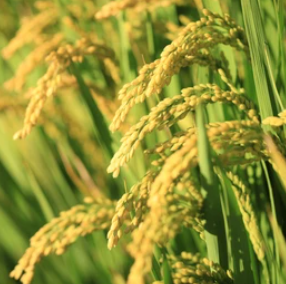Information report for OsHT;OsLHT1
Gene Details
|

|
Functional Descriptions
- Using a degenerative probe designed according to the most conservative region of a known Lys- and His-specific amino acid transporter (LHT1) from Arabidopsis, we isolated a full-length cDNA named OsHT (histidine transporter of Oryza sativa L.
- Multiple sequence alignments showed that OsHT shares a high degree of sequence conservation at the deduced amino acid level with the Arabidopsis LHT1 and six putative lysine and histidine transporters.
- Functional complementation experiments demonstrated that OsHT was able to work as a histidine transporter in Saccharomyces cerevisiae, suggesting that OsHT is a gene that encodes for a histidine transporter from rice.
- OsHT, a rice gene encoding for a plasma-membrane localized histidine transporter.
- QRT-PCR analysis indicated that OsLHT1 was expressed in various rice organs, including root, stem, flag leaf, flag leaf sheath and young panicle.
- Two OsLHT1 mutants were generated using CRISPR/Cas9 genome-editing technology, and the loss-of-function of OsLHT1 inhibited rice root and shoot growth, thereby markedly reducing grain yields.
- The aims of this study are to analyze the substrate selectivity of OsLHT1 and influence of its disruption on rice growth and fecundity.
- Our results indicated that OsLHT1 is an amino acid transporter with wide substrate specificity and with preference for neutral and acidic amino acids, and disruption of OsLHT1 function markedly inhibited rice growth and fecundity.
- OsLHT1 (Lysine/Histidine transporter) has been previously reported as a histidine transporter in yeast, but its substrate profile and function in planta are unclear.
- Transient expression in rice protoplast suggested OsLHT1 was localized to the plasma membrane, which is consistent with its function as an amino acid transporter.
- OsLHT1 is localized throughout the rice root, including root hairs, epidermis, cortex and stele, and to the leaf vasculature.
- Knockout of OsLHT1 in japonica resulted in reduced root uptake of amino acids.
- 15 N-ammonium uptake and subsequently the delivery of root synthesized amino acids to OsLHT1 shoots were also significantly decreased, which was accompanied by reduced shoot growth.
- These results together provide evidence that OsLHT1 functions in both root uptake and root to shoot allocation of a broad spectrum of amino acids in rice.
- When expressed in yeast, OsLHT1 supported cell growth on a broad spectrum of amino acids and effectively transported aspartate, asparagine and glutamate.
- Rice OsLHT1 Functions in Leaf-to-Panicle Nitrogen Allocation for Grain Yield and Quality.
- The concentrations of both total N and free amino acids in the flag leaf were similar at anthesis between OsLHT1 lines and WT while significantly higher in the mutants than WT at maturation.
- OsLHT1 is expressed in vascular bundles of leaves, rachis, and flowering organs.
- OsLHT1 plants showed lower panicle length and seed setting rate, especially lower grain number per panicle and total grain weight.
- In this study, we planted knockout mutant lines of OsLHT1 together wild-type (WT) in paddy field for evaluating OsLHT1 function in N redistribution and grain production.
- Taken together, we conclude that OsLHT1 plays critical role in the translocation of amino acids from vegetative to reproductive organs for grain yield and quality of nutrition and functionality.
- The OsLHT1 seeds contained higher proteins and most of the essential free amino acids, similar total starch but less amylose with lower paste viscosity than WT seeds.
- Knockout of amino acid transporter gene OsLHT1 accelerates leaf senescence and enhances resistance to rice blast fungus.
- In comparison to wild type, OsLHT1 mutant lines showed sustained rusty red spots on fully mature leaf blades irrespective of N supply levels.
- Notably, no relationship between the severity of leaf rusty red spots and concentration of total N or amino acids was found in OsLHT1 mutants at different developmental stages.
- OsLHT1 inactivation dramatically prevented the leaf invasion of M.
- In this study, we found that rice amino acid transporter gene OsLHT1 was expressed in leaves and up-regulated by maturing, N starvation and inoculation of blast fungus and N supply-dependent premature senescence of leaves at vegetative growth stage.
- Disruption of OsLHT1 altered transport and metabolism of amino acids and and salicylic acid-related defense genes and production of jasmonic acid and salicylic acid, accumulation of reactive oxygen species.
Functional Keywords
- transporter , leaf , root , growth , shoot , panicle , grain , sheath , grain-yield , plasma-membrane , amino-acid-transporter , root-hair , nitrogen , vascular-bundle , grain-number , seed , starch , yield , vegetative , R-protein , reproductive , quality , grain-weight , flowering , panicle-length , leaf-senescence , senescence , resistance , defense , salicylic-acid , blast , jasmonic , jasmonic-acid , reactive-oxygen-species
Literature and News
- OsHT, a rice gene encoding for a plasma-membrane localized histidine transporter . DOI: 10.1111/j.1744-7909.2005.00016.x
- Disruption of an amino acid transporter LHT1 leads to growth inhibition and low yields in rice . DOI: 10.1186/s12870-019-1885-9 ; PMID: 31221084
- Oryza sativa Lysine-Histidine-type Transporter 1 functions in root uptake and root-to-shoot allocation of amino acids in rice . DOI: 10.1111/tpj.14742 ; PMID: 32159895
- Rice OsLHT1 Functions in Leaf-to-Panicle Nitrogen Allocation for Grain Yield and Quality . DOI: 10.3389/fpls.2020.01150 ; PMID: 32849708
- Nitrogen Mediates Flowering Time and Nitrogen Use Efficiency via Floral Regulators in Rice . DOI: 10.1016/j.cub.2020.10.095 ; PMID: 33278354
- The Amino Acid Transporter OsAAP4 Contributes to Rice Tillering and Grain Yield by Regulating Neutral Amino Acid Allocation through Two Splicing Variants . DOI: 10.1186/s12284-020-00446-9 ; PMID: 33409665
- Overexpression of OsERF83, a Vascular Tissue-Specific Transcription Factor Gene, Confers Drought Tolerance in Rice . DOI: 10.3390/ijms22147656 ; PMID: 34299275
- Knock out of amino acid transporter gene OsLHT1 accelerates leaf senescence and enhances resistance to rice blast fungus . DOI: 10.1093/jxb/erad125 ; PMID: 37010326
Gene Resources
- UniProt: Q6ZK52
- EMBL: AK065217, AK102015, AP014964
- AlphaFoldDB: Q6ZK52
- EnsemblPlants: Os08t0127100-01, Os08t0127100-02
- Gramene: Os08t0127100-01, Os08t0127100-02
- KEGG: osa:4344567
- Orthologous matrix: IGAVCTM
Sequences
cDNA Sequence
- >LOC_Os08g03350.1
GGGCTTAATAATCTTCTTCCTCTTGTTCTTCTATAAGTAGAGACTTGGCGACTCTGATCTGCCGGCCTCCTTGCAGCAACCCTTCTTCTTCTTCTTCTTCTTCTTCTTCTTCCTCTGATCCTCCATTGCTGCAAAAGAAGAAGAGGTAGACGAAGGAGGAGGAGATCAGGTGATCATGGGGACTCAGGTGGCAGATAACTACCCACCGGCCAAGGATGGCCGGAGCGCGCAGGAGAAGGCGATCGACGACTGGCTTCCCATCACGTCGTCCAGGAACGCCAAGTGGTGGTACTCCGCCTTCCACAATGTCACCGCCATGGTCGGCGCCGGCGTCCTCAGCCTCCCCTACGCCATGTCCGAGCTCGGCTGGGGACCTGGCATCGCGGTGCTGATCCTGTCATGGATCATCACGCTCTACACGCTGTGGCAGATGGTGGAGATGCACGAGATGGTGCCCGGGAAGCGGTTCGACAGGTACCACGAGCTCGGGCAGCACGCGTTCGGCGAGAAGCTGGGCCTCTGGATCGTGGTGCCGCAGCAGCTCGTCGTCGAGGTCGGCGTCAACATCGTGTACATGGTCACCGGCGGCAAGTCGCTGAAGAAGTTCCACGACGTGCTCTGCGAGGGCCACGGCTGCAAGAACATCAAGCTCACCTACTTCATCATGATCTTCGCCTCCGTCCACTTCGTCCTCTCGCAGCTCCCAAACTTCAACTCCATCTCCGGCGTGTCCCTCGCCGCCGCCGTCATGTCGCTCAGCTACTCCACCATCGCGTGGGGCGCGTCGGTGGACAAGGGGAAGGTGGCCGACGTCGACTACCACCTGCGCGCCACGACGTCGACGGGGAAGGTGTTCGGCTTCTTCAGCGCGCTGGGCGACGTCGCGTTCGCGTACGCGGGGCACAACGTGGTGCTGGAGATCCAGGCGACCATCCCGTCGACGCCGGAGAAGCCGTCCAAGAAGCCGATGTGGAAGGGCGTCGTCGTCGCCTACATCATCGTCGCGCTCTGCTACTTCCCCGTGGCGCTCGTCGGATACTGGGCGTTCGGCAACCACGTCGACGACAACATCCTCATCACGCTCTCCAGGCCCAAATGGCTCATCGCGCTCGCAAACATGATGGTCGTCATCCATGTCATCGGGAGCTACCAGATCTACGCCATGCCGGTGTTCGACATGATCGAGACCGTGCTCGTCAAGAAGCTCAGATTCCCTCCCGGCCTCACGCTTCGCCTCATCGCAAGAACACTCTACGTTGCGTTCACCATGTTCATCGCGATCACCTTCCCGTTCTTCGGTGGATTGCTTGGGTTCTTCGGTGGATTCGCCTTCGCGCCAACTACTTACTTCCTTCCCTGCATCATGTGGCTAGCAATCTACAAGCCAAGAAGGTTCAGTCTCTCATGGTTCACCAACTGGATCTGCATCATTCTTGGAGTGATGCTCATGATCCTGTCACCAATCGGAGGACTCCGGCAGATCATCATAGATGCCAAGACATACAAGTTCTACTCGTAGATTACATGTTCATCATAGTAATCTCATGTGGCTGCAAGTTCAAGTTCTACTCATAGGCACACATGATGAAACCAGTTACTGCAAAAGTTTTTTTTTTAGCCAACAAAGGAAGAAGAAAGTTCAACACCAAGTTCATACATTGTCACTACGACGATGATCTTTTGAGACGTGTCATGCATGCATCAGTCGTTAATTATGTGACTTAATTAAAAACAAAGAGGTTGTGTTTGTGCATTGTCGCTGGGTTAATCATACTGTGTTTTTATATTTCAATCTACTATTATATTGTAGGCTGGACATGGAAACTGTGTGCAGAAAGATGAAAGGGATGGATAATTACTGGTTGATTCTTTTGCTTTCAAGTCTA
CDS Sequence
- >LOC_Os08g03350.1
ATGGGGACTCAGGTGGCAGATAACTACCCACCGGCCAAGGATGGCCGGAGCGCGCAGGAGAAGGCGATCGACGACTGGCTTCCCATCACGTCGTCCAGGAACGCCAAGTGGTGGTACTCCGCCTTCCACAATGTCACCGCCATGGTCGGCGCCGGCGTCCTCAGCCTCCCCTACGCCATGTCCGAGCTCGGCTGGGGACCTGGCATCGCGGTGCTGATCCTGTCATGGATCATCACGCTCTACACGCTGTGGCAGATGGTGGAGATGCACGAGATGGTGCCCGGGAAGCGGTTCGACAGGTACCACGAGCTCGGGCAGCACGCGTTCGGCGAGAAGCTGGGCCTCTGGATCGTGGTGCCGCAGCAGCTCGTCGTCGAGGTCGGCGTCAACATCGTGTACATGGTCACCGGCGGCAAGTCGCTGAAGAAGTTCCACGACGTGCTCTGCGAGGGCCACGGCTGCAAGAACATCAAGCTCACCTACTTCATCATGATCTTCGCCTCCGTCCACTTCGTCCTCTCGCAGCTCCCAAACTTCAACTCCATCTCCGGCGTGTCCCTCGCCGCCGCCGTCATGTCGCTCAGCTACTCCACCATCGCGTGGGGCGCGTCGGTGGACAAGGGGAAGGTGGCCGACGTCGACTACCACCTGCGCGCCACGACGTCGACGGGGAAGGTGTTCGGCTTCTTCAGCGCGCTGGGCGACGTCGCGTTCGCGTACGCGGGGCACAACGTGGTGCTGGAGATCCAGGCGACCATCCCGTCGACGCCGGAGAAGCCGTCCAAGAAGCCGATGTGGAAGGGCGTCGTCGTCGCCTACATCATCGTCGCGCTCTGCTACTTCCCCGTGGCGCTCGTCGGATACTGGGCGTTCGGCAACCACGTCGACGACAACATCCTCATCACGCTCTCCAGGCCCAAATGGCTCATCGCGCTCGCAAACATGATGGTCGTCATCCATGTCATCGGGAGCTACCAGATCTACGCCATGCCGGTGTTCGACATGATCGAGACCGTGCTCGTCAAGAAGCTCAGATTCCCTCCCGGCCTCACGCTTCGCCTCATCGCAAGAACACTCTACGTTGCGTTCACCATGTTCATCGCGATCACCTTCCCGTTCTTCGGTGGATTGCTTGGGTTCTTCGGTGGATTCGCCTTCGCGCCAACTACTTACTTCCTTCCCTGCATCATGTGGCTAGCAATCTACAAGCCAAGAAGGTTCAGTCTCTCATGGTTCACCAACTGGATCTGCATCATTCTTGGAGTGATGCTCATGATCCTGTCACCAATCGGAGGACTCCGGCAGATCATCATAGATGCCAAGACATACAAGTTCTACTCGTAG
Protein Sequence
- >LOC_Os08g03350.1
MGTQVADNYPPAKDGRSAQEKAIDDWLPITSSRNAKWWYSAFHNVTAMVGAGVLSLPYAMSELGWGPGIAVLILSWIITLYTLWQMVEMHEMVPGKRFDRYHELGQHAFGEKLGLWIVVPQQLVVEVGVNIVYMVTGGKSLKKFHDVLCEGHGCKNIKLTYFIMIFASVHFVLSQLPNFNSISGVSLAAAVMSLSYSTIAWGASVDKGKVADVDYHLRATTSTGKVFGFFSALGDVAFAYAGHNVVLEIQATIPSTPEKPSKKPMWKGVVVAYIIVALCYFPVALVGYWAFGNHVDDNILITLSRPKWLIALANMMVVIHVIGSYQIYAMPVFDMIETVLVKKLRFPPGLTLRLIARTLYVAFTMFIAITFPFFGGLLGFFGGFAFAPTTYFLPCIMWLAIYKPRRFSLSWFTNWICIILGVMLMILSPIGGLRQIIIDAKTYKFYS*